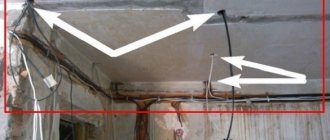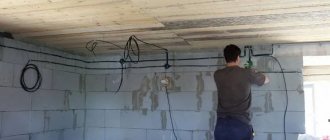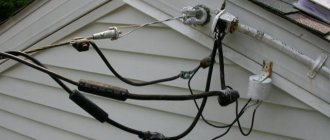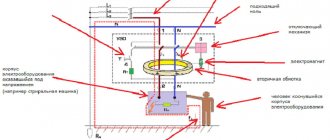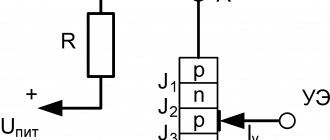Electricity is something without which it is impossible to imagine life in the modern world. Therefore, the profession of an electrician is in demand today. You can get it by graduating from college or taking a short course. And to become an electrical engineer, you will need to study at a university. And if you want to master electricity in everyday life and understand the basic terms and skills, a training course for a young electrician from Vladimir Kozin will help you with this.
Electrical laws and formulas are required not only for carrying out any calculations. They are also needed by those who practically perform operations related to electricity. Knowing the basics of electrical engineering, you can logically determine the cause of the malfunction and eliminate it very quickly.
Young electrician course
This young electrician course is mainly intended for novice electricians. In it we will look at connecting sockets, switches, and light bulbs. Let's figure out what electric current is and what voltage is. Using video examples, you will learn what an electrical circuit is and how it consists and works. Learn how an electrical circuit works with a switch, as well as with a two-button switch..
Vladimir Kozin
Summary of the course: the video course consists of 5 parts, each with 2 lessons. Young electrician course with a total duration of about 3 hours.
- In the first part you will be introduced to the basics of electrical engineering, consider the simplest diagrams for connecting light bulbs, switches, sockets and learn about the types of electrician's tools;
- In the second part you will be told about the types and purposes of materials for the work of an electrician: cables, wires, cords and you will assemble a simple electrical circuit;
- In the third part you will learn how to make switch connections and parallel connections in electrical circuits;
- In the fourth part you will see the assembly of an electrical circuit with a two-key switch and a model of the power supply of the room;
- In part five, you will look at a complete model of the electrical supply of a room with a switch and get tips on safety when working with electrical equipment.
Training course for a young electrician
The ultimate goal of training. This is to give you an understanding of what electricity is and how to work with it correctly. As a result of studying the course, you will learn what materials and cables to use during installation work, learn how to assemble a simple electrical circuit, a circuit with a socket or two-button switch, a circuit with a parallel connection of lighting fixtures with a switch. You can assemble the complete electrical circuit of the room yourself.
The main thing is to take a responsible approach to studying all the nuances - electricity does not forgive mistakes. Remember, your safety and the health of others should come first.
We invite you to familiarize yourself with other educational video lessons on electrical topics:
- DIY electrics in apartments and houses
- Electrical for your home
Electrician courses, video tutorials on proper wiring installation
Laying wiring in the house and on the property to ensure lighting and operation of household appliances is a very important stage, during which many make mistakes, not having the opportunity to take electrician training courses. And incorrectly done wiring threatens not only short circuits in sockets, which can damage equipment, but also burnout of the entire network. And even the confidence that you did everything correctly does not guarantee that mistakes were not made. There are many striking examples of this.
Laying inexpensive cable. Every homeowner, when building his home, tries to save money wherever possible. And if the use of cheap materials can affect the reliability of the building, then purchasing inexpensive wiring seems quite acceptable.
It doesn’t matter whether you are making a house for yourself or have contracted to make a house for someone else, you cannot carry out poor-quality installation of electrical wiring with your own hands; a video recorded by professionals will inform you in detail which cables are unacceptable today. In particular, at present very cheap PUNP wires are still produced, which, due to their fire hazard, are categorically not recommended by specialists, taking into account modern GOST standards. In the best case, permanent damage awaits you; in the worst case, everything can end with completely burnt out wiring.
- Learn more about the video course “Your own electrician” →
It's very easy to make mistakes when laying a network if you don't know the basics of electrical engineering, and in many situations, having a detailed training video can save you from making mistakes. Want an example of the most common violation?
Pulling cables through walls and ceilings without embedded elements. As a rule, if you need to make wiring between rooms, most people follow the simplest path, that is, they take a hammer drill and make a hole in the wall, after which they immediately pull the wire through it. This is categorically unacceptable in wooden buildings, and extremely undesirable in concrete and brick ones.
Basics of Electrical Engineering
In the first video lesson “young electrician course”, you will be told who the young electrician course is intended for. In it we will look at connecting sockets, switches, and light bulbs. Learn what electric current is and what voltage is.
Any electrical circuit contains a source of electrical energy and a receiver of electrical energy. Consider a simple electrical circuit consisting of a battery and an incandescent light bulb. The battery is the source of electrical energy, and the light bulb is the receiver.
Learn Ohm's law for a simple circuit. Voltage, resistance of an electrical circuit and passing electric current are related to each other by Ohm's law. It’s easier to remember these dependencies using Ohm’s triangle.
Typically these circuits are described by Kirchhoff's laws. When connecting conductors in parallel, the power source voltage is applied to both conductors. And with a serial connection, the receivers are connected one after another.
Conductors can be connected both in parallel and in series. Series connection of conductors. The total resistance of series-connected conductors. An example of a series connection of conductors. New Year's garland.
The role of Ohm's Law and Kirchhoff's Law in the life of an electrician. Why does an electrician need a head? Consequences of ill-considered actions.
Corrections version of the first lesson.
This lesson corrects Vladimir Kozin's slips using splash screens.
Main characteristics of current
The main characteristics include current, voltage, resistance and power. The parameters of the electric current flowing through the wire are characterized by these values.
Current strength
The parameter means the amount of charge passing through the wire in a certain time. Current strength is measured in amperes.
Voltage
This is nothing more than the potential difference between two points of a conductor. The value is measured in volts. One volt is the potential difference at which to transfer a charge of 1 coulomb it will be necessary to perform work equal to one joule.
Resistance
This parameter is measured in ohms. Its value determines the resistance to energy flow. The greater the mass and cross-sectional area of the conductor, the greater the resistance. It also depends on the material and length of the wire. If the potential difference at the ends of the conductor is 1 Volt and the current is 1 Ampere, the resistance of the conductor is 1 Ohm.
Power
A physical quantity expresses the speed of flow of electricity in a conductor. Current power is determined by the product of current and voltage. The unit of power is watt.
Ohm's law
The current strength in a section of an electrical circuit is directly proportional to the voltage at the ends of the section and inversely proportional to its resistance
Ohm's law
Definition of Ohm's law in simple words
An electrical circuit consists of a two-pole voltage source, that is, a battery, accumulator or generator. If the poles of the source are connected with wires, then an electric current will flow through them. Its value is determined by the resistance of the conductors.
A visual representation of this dependence is an ordinary plumbing system. An analogue of a voltage source is a pump or water tower that creates pressure in the main, the amount of water passing through the pipe is a kind of current, and the tap corresponds to the resistance. Fully open, it does not restrict the flow; as it is twisted, the water hole decreases until it closes completely.
Where to start learning?
The first thing you need to become an electrician is to master the appropriate amount of knowledge. You must learn to navigate basic electrical quantities, operating principles of elementary circuits, and radio components. You also need to understand the laws of electric current flow, voltage transmission, etc.
In relation to the chosen profession, it is necessary to study the relevant literature or take a course according to the educational institution’s program.
University, technical school, college
If you decide to become an experienced electrician, then training at a specialized institution will not hurt you. Today, many universities, technical schools and colleges provide vocational education for electricians in various areas.
Let's look at the features of training courses for each of them:
- Higher educational institutions will require about 4 to 5 years of training from a beginning electrician. Compared to other types of institutions for training electricians, they provide a minimal practical base, but they prepare good specialists with deep theoretical knowledge in the electrical field. An important criterion is obtaining an 11th grade education or having a professional one that excludes such a need.
- Technical school represents the golden mean in terms of theoretical and practical skills that an electrician receives after graduation. Of course, the theory is not studied in such a detailed manner, but this is more than enough to produce competent electricians. Training can be carried out either after 9th grade for 4 years, or after 11th grade for 3 years.
- College or school - prepares the working professions of electricians; as a rule, the theoretical part here is kept to a minimum, maximum emphasis is placed on acquiring practical skills. An electrician's license can be obtained fairly quickly - from 1 to 3 years.
The above training options provide the opportunity for both paid and free education. As a result, you receive a diploma or certificate of appropriate qualifications, and some institutions even take care of the employment of their graduates.
Of course, not all offers will exceed the average salary, but this will be an excellent platform for practical consolidation of knowledge. A significant disadvantage is the rather lengthy process to become an electrician.
Courses
Professional courses for electricians have become especially popular in the modern world, where the constant development of the labor market creates constant demand. Thanks to this, you can become an electrician in such special courses in 2 to 8 weeks. Training can take place both online and offline, which greatly simplifies the process of mastering the profession of an electrician. Depending on the specific course, you can take it either from a textbook or through webinars or conferences.
The disadvantage of training in courses is that the amount of information is rather small; a novice electrician receives exposure to the basics of electrical engineering and narrowly focused practical recommendations. Which he will be able to test directly in independent practice. In addition, courses are always offered on a paid basis.
A significant advantage is much greater freedom - to obtain a certificate, you can not leave another job or study and master the profession of an electrician in parallel. Also during the courses you will get a summary of what concerns a specific type of activity.
Self-study
If none of the above methods suits you, you can become an electrician yourself by studying the information you are interested in in the literature or on the Internet. Having joined the ranks of home craftsmen, you are unlikely to be able to perform any complex work, but installing wiring in an apartment or installing simple household equipment will be a clear and easily implemented task for you.
To become an experienced self-study specialist, you will still need the help of a qualified specialist. It is advisable to work with practitioners, if there is an opportunity to be hired as an electrician’s assistant, at least for a nominal fee - this would be an ideal option.
At the initial stage, an apprentice electrician will be entrusted with the simplest operations (shaping walls, drilling holes, laying wires, well, bring it - give it), here it is important to carefully complete all the tasks and watch what your mentor is doing.
Wall chipping
After some time, you will be able to repeat the same work yourself without any problems.
Electrician's tool
In the second video lesson “young electrician course”, you will learn what electrician tools you will need. An electrician's kit may consist of several tools. These are pliers (pliers), a mounting knife, a set of screwdrivers, round nose pliers and a measuring device. All tools must have insulated handles.
All instruments
You can find a knife with a triangular blade on sale. Instead of a set, you can use a universal screwdriver. Pliers are used to cut and twist wires. Using round-nose pliers, the wires are terminated in the form of a ring. A measuring screwdriver can be used as a measuring device to determine the phase.
What do electrician's tools look like? Minimum set.
For other measurements, a multimeter is used. It can measure voltage, resistance and current. You can also test the wires with a multimeter. The main thing is to check all devices before use.
Electrical cables
In the third video lesson “young electrician course”, you will learn what electrical cables and flexible cords are needed for electrical installation. Construction of electrical wires and cables. Which wires are used only for external work and for internal electrical installations.
Selection of wire (cable) cross-section based on power
Example.
Let's take a one-room apartment. What electrical appliances do we use? Below you will see a table showing electrical appliances and tools used in everyday life:
| Household electrical appliance | Power, W | Household electrical appliance | Power, W |
| Bulb | 15 – 250 | Oven | 1000 – 3000 |
| Inkjet printer | 30 – 50 | microwave | 1500 – 3000 |
| Scales | 40 – 300 | Vacuum cleaner | 400 – 2000 |
| Audio system | 50 – 250 | Meat grinder | 1500 – 2200 |
| Computer | 300 – 800 | Toaster | 500 – 1500 |
| Laser printer | 200 – 500 | Grill | 1200 – 2000 |
| Copy machine | 300 – 1000 | Coffee grinder | 500 – 1500 |
| TV | 100 – 400 | Coffee maker | 500 – 1500 |
| Fridge | 150 – 2000 | Dishwasher | 1000 – 2000 |
| Washing machine | 1000 – 3000 | Iron | 1000 – 2000 |
| Electric kettle | 1000 –2000 | Heater | 500 – 3000 |
| Electric stove | 1000 – 6000 | Air conditioner | 1000 – 3000 |
Switch connection
In the fifth video lesson “young electrician course”, you will learn how to correctly connect switches. How does the circuit breaker connection diagram work, what is the difference between phase and zero. And also how to determine the phase wire if the house has a three-wire power supply.
Usually, to disassemble the switch, you need to remove its key. There are screws under the key that need to be removed. We gain access to the switch terminals where the wires are connected.
Sometimes special latches are used to secure the switch body. In this case, they must be squeezed out carefully so as not to break. To connect the switch, cut one of the wires that goes from the electrical box to the light bulb. According to the regulations, you need to cut the phase wire.
Light switch
light switch diagram
A switch is a device with which you can turn on and off the lights in the house. It is often not noticed, and therefore its significance is not fully appreciated. In fact, switches perform an important function: they provide power to electrical appliances.
During renovations, when installing a lighting system, many people, due to ignorance of the variety of switches, buy ordinary single-key models. At the same time, they may not suit the interior or may not withstand stress at all. That is why before purchasing it is important to understand how to choose lighting switches.
What does it take to become an electrician?
To become an electrician, you first need to determine the direction you are interested in and the relevant features of the work.
In each of them there is a certain gradation according to:
- professions (electrician, electrician, electrician, engineer, etc.);
- qualification categories or categories on which the electrician’s salary and the list of works acceptable for performance in terms of technical and technological complexity and responsibility directly depend;
- clearance level - determines the compliance of the employee’s knowledge and skills in terms of labor protection and electrical safety, which are necessarily taken into account when servicing devices and determine the possibility of performing certain categories of work.
To become a professional electrician, you need to obtain an appropriate level of knowledge in this profession, which is confirmed by some document. After this, training takes place on electrical safety issues and technical operating rules to assign a qualification approval group.
How to connect a double switch
In the seventh video lesson “young electrician course”, you will learn how to correctly connect a two-key switch to two light bulbs. Double switches usually have 3 connection terminals. The phase is brought to a common mark.
The output load is connected to the other two marks. Other wires from the loads are connected to the neutral wire of the voltage source. Chandeliers are connected to apartments using the following electrical circuit.
It is not always possible to replace two single switches with one double switch. They can be connected in different ways.
For example, one can interrupt a phase, and the other zero. In this case, you need to change the wiring diagram, or use a double switch that does not have a common contact and has 4 pins. If there is a jumper between the two inputs, remove it.
Power supply diagram
In the ninth video lesson “young electrician course”, we will look at the complete power supply diagram of the room. In addition to the diagram from the last lesson, we will need 2 circuit breakers rated 16A and a piece of insulated wire.
One circuit breaker will protect the light line and the other will protect the outlet line. Our electrical circuit has become secure. In the event of a short circuit or line overload, the circuit breaker will disconnect the faulty circuit. This also prevents fire.
electrical safety
In the tenth video lesson “young electrician course”, you will learn how all metal parts of electrical installations, which are not normally energized, must be grounded.
This grounding is called protective grounding. Serves to protect operating personnel from electric shock. In electrical installations, the housings of electrical machines, as well as metal structures associated with the installation of electrical equipment, are grounded.
The degree of electric shock depends on the strength of the current itself and the time it takes to pass through the human body. The strength of the current depends on the voltage in the circuit and the resistance of the body itself. According to Ohm's law. The resistance of the body depends on the state of the person at the moment. A voltage of no more than 50 volts is considered safe.
Types of circuits, voltage and current
Electrical circuits can be connected in parallel or in series. In the first case, the electric current is distributed over all circuits that are connected in parallel. It turns out that the total unit will be equal to the sum of the current in any of the circuits.
Parallel connections have the same voltage. In a series combination, current flows from one system to another. As a result, the same current flows in each line.
It makes no sense to dwell on the technical definitions of voltage and current (A). The explanation will be much clearer with examples. So, the first parameter affects how well different areas need to be isolated. The larger it is, the higher the likelihood that a breakdown will occur in some place. It follows from this that high voltage requires high-quality insulation . Exposed connections must be kept away from each other, from other materials and from the ground.
Electrical voltage (U) is usually measured in Volts.
More powerful voltage poses a greater threat to life. But you shouldn’t assume that low is absolutely safe. The danger to humans also depends on the strength of the current that passes through the body. And this parameter is directly dependent on resistance and voltage. In this case, the body's resistance is associated with skin resistance, which can vary depending on the moral and physical state of a person, humidity and many other factors. There have been cases when a person died from an electric shock of only 12 volts.
In addition, depending on the current strength, different wires are selected. The higher the A, the thicker the wire needed.




